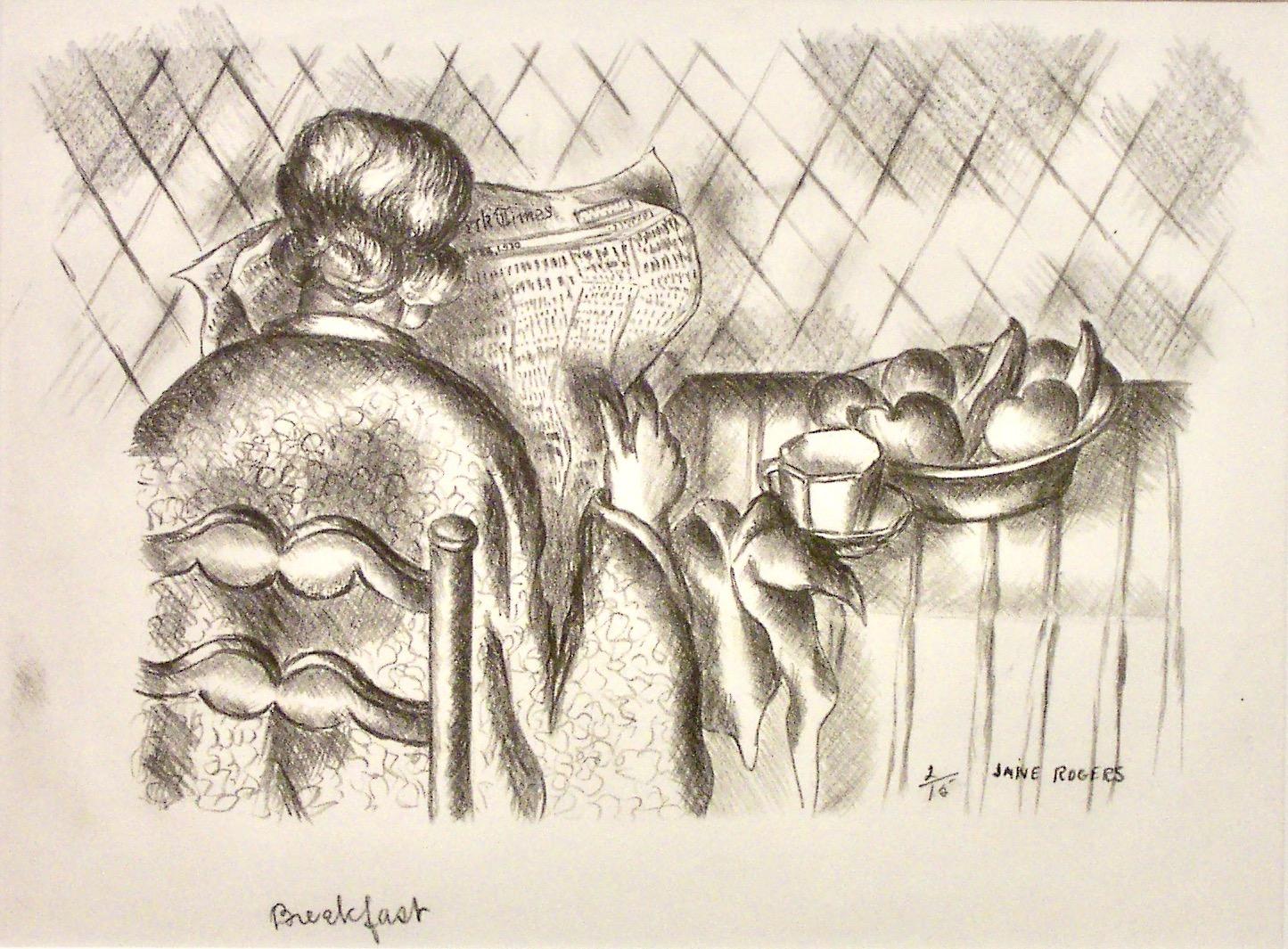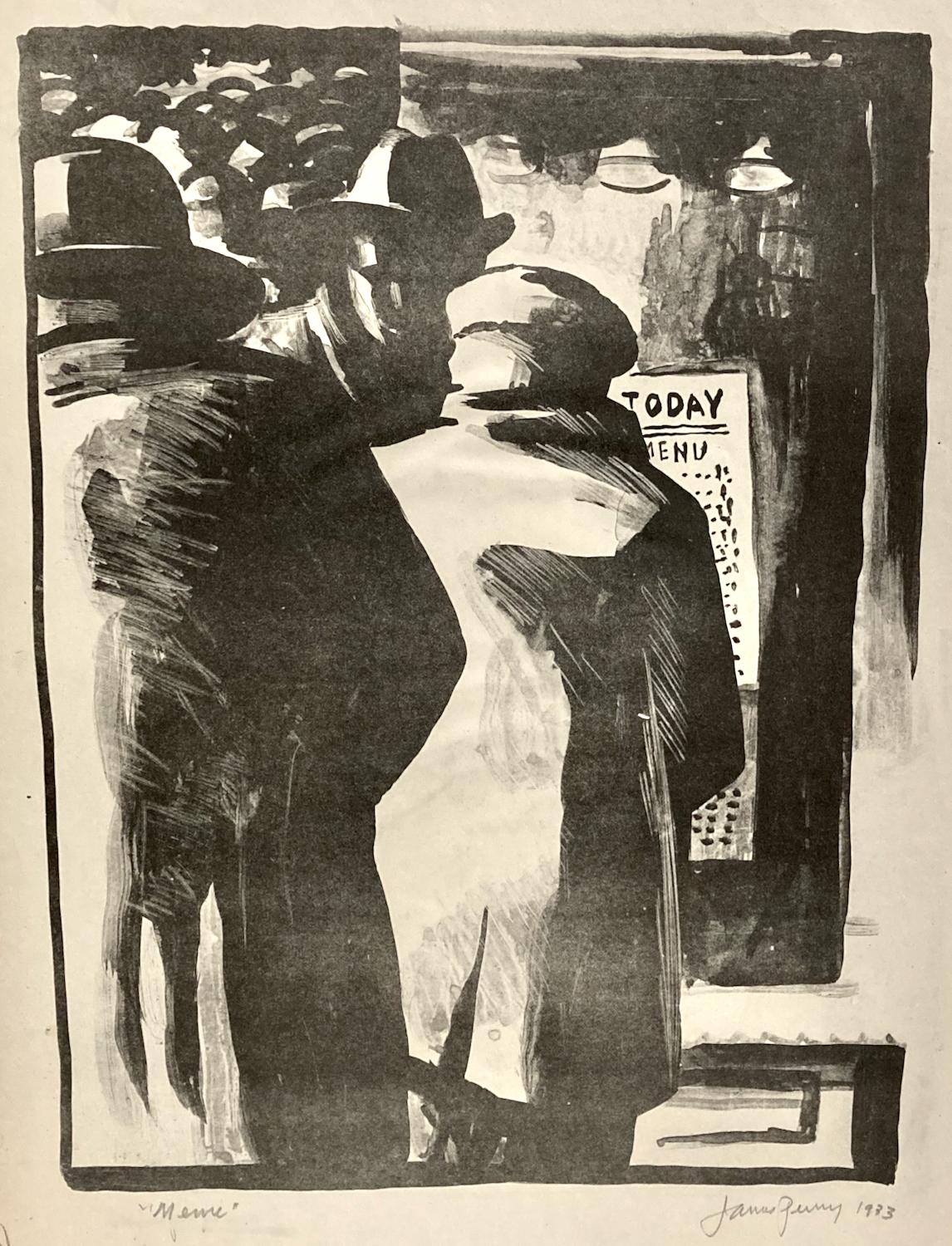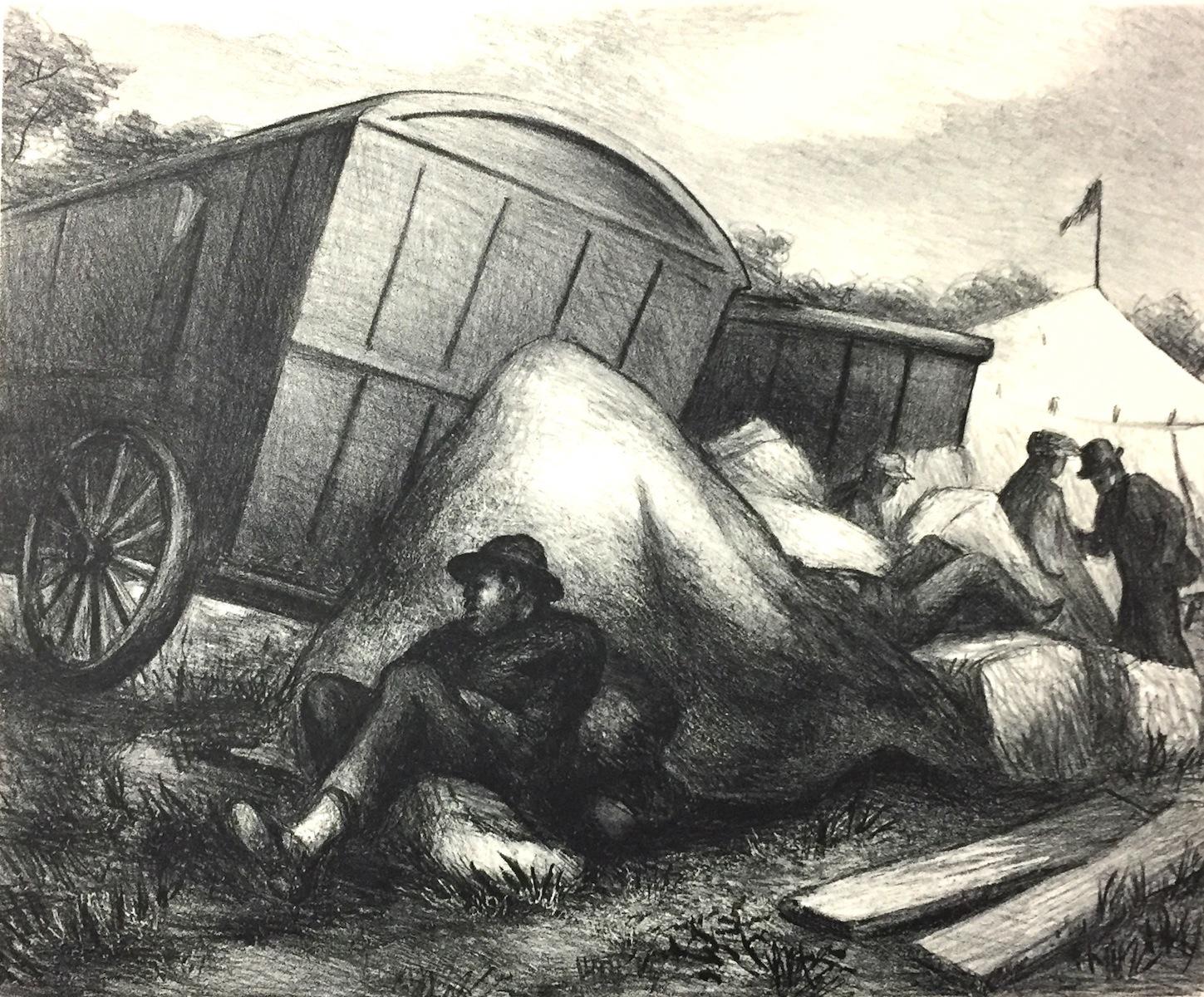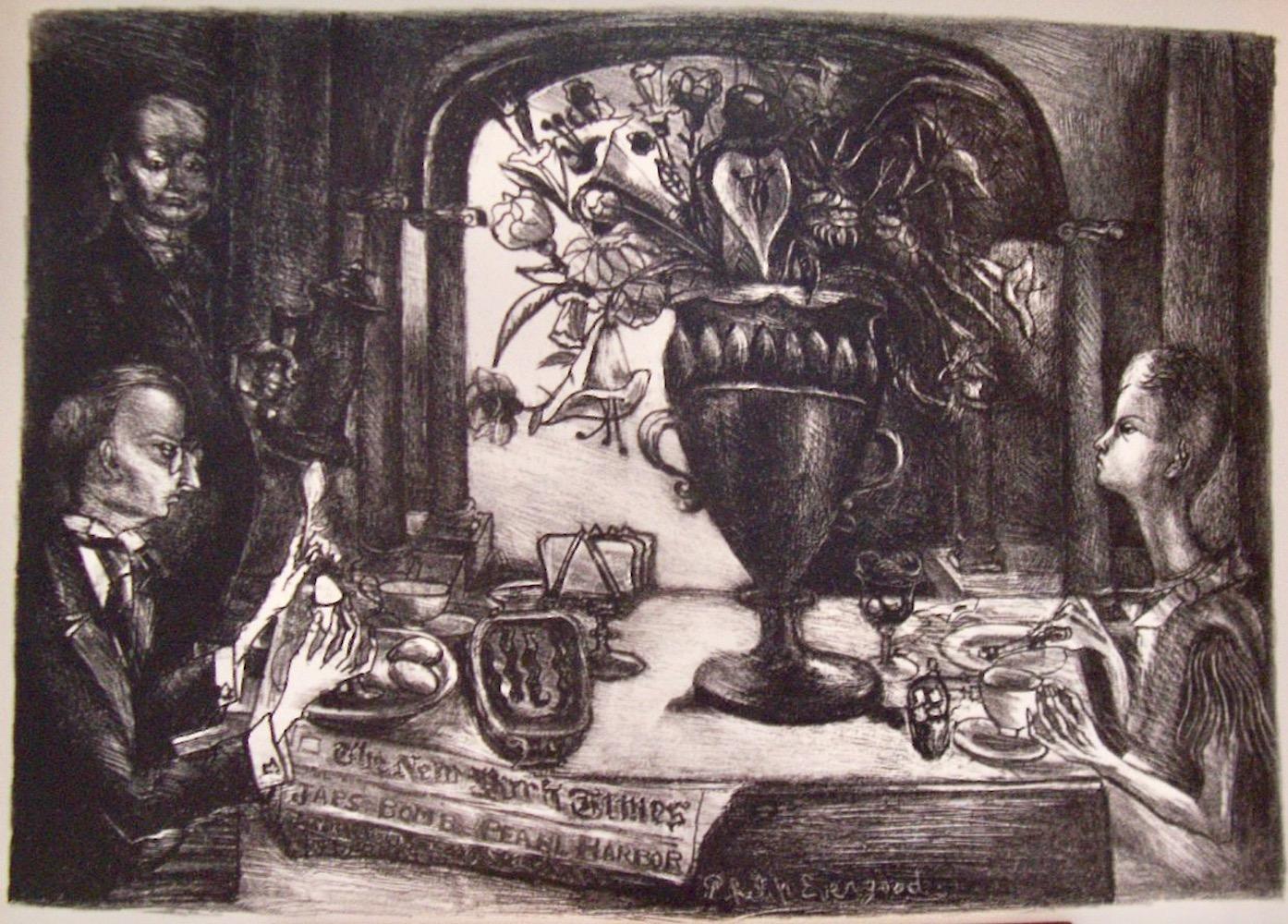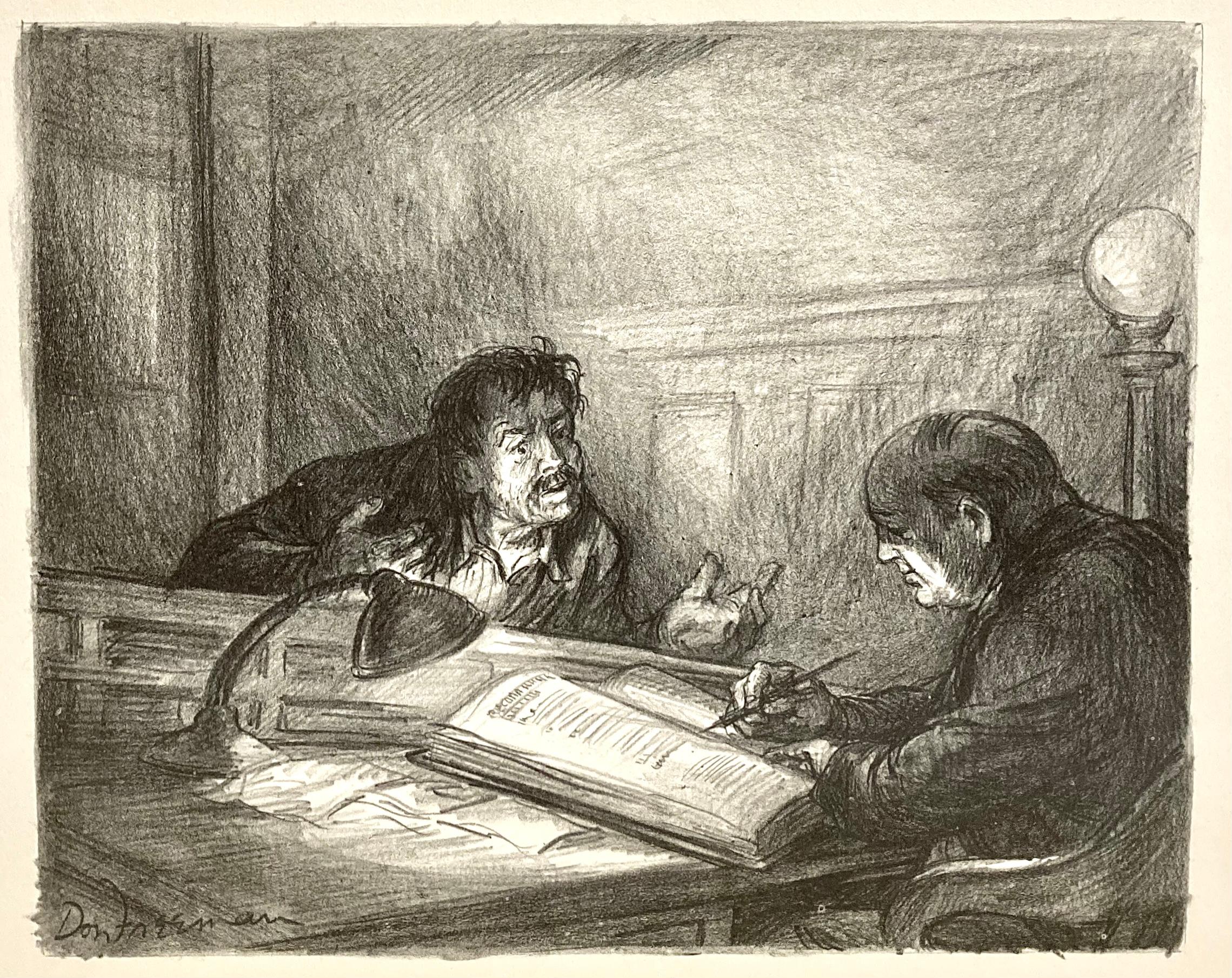Items Similar to 'Hurdy Gurdy Ballet' — 1920s New York — American Scene
Want more images or videos?
Request additional images or videos from the seller
1 of 6
Glenn O. Coleman'Hurdy Gurdy Ballet' — 1920s New York — American Scene1928
1928
About the Item
Glenn O. Coleman, 'Hurdy Gurdy Ballet', lithograph 1928, edition 50. Signed, dated, and numbered '14/50' in pencil.
Titled in the bottom left margin, in another hand. Numbered '14' in the lower right sheet edge, in pencil. A fine, richly-inked impression, on cream wove paper, with wide margins (1 1/4 to 2 1/8 inches), in excellent condition. Image size 12 1/8 x 15 15/16 inches (308 x 405 mm); sheet size 15 1/2 x 20 1/8 inches (394 x 511 mm). Archivally matted to museum standards, unframed.
From the portfolio 'Lithographs of New York' — 12 lithographs printed by master lithographer George C. Miller, exhibited at the Whitney Studio Galleries, November 1- 24, 1928.
Exhibited: 'A Century of Creativity: The MacDowell Colony,' 1907-2007, Library of Congress, February – August 2007. 'Life of the People: realist prints and drawings from the Ben and Beatrice Goldstein Collection,' 1912-1948, Library of Congress, 1999.
Impressions of this work are held in the collections of the Addison Gallery of American Art, Brooklyn Museum, Detroit Institute of Arts, Philadelphia Museum of Art, Library of Congress, The Phillips Collection, and the Whitney Museum of American Art.
ABOUT THE ARTIST
Glenn O. Coleman’s career (1887-1932) as a celebrated New York illustrator, painter, and printmaker was a short one. Born in Ohio in 1887, he grew up in Indiana and arrived in Manhattan in 1905 to attend the New York School of Art, studying under William Merritt Chase, Robert Henri, and Everett Shinn.
Coleman earned a name for himself in the 1910s and 1920s city art scene with his personal depictions of street life and working-class people. His illustrations (some of which he produced as lithographs) and paintings reflected the subject matter of his Ashcan teachers: Bowery bums, election night bonfires, slum kids, cops, criminals, “silk-hatted tourists,” bar stool sitters, and other denizens of Lower Manhattan’s corners and hidden enclaves.
In 1910, Henri said this about Coleman, who was exhibiting a series of drawings in New York called 'Scenes From the Life of the People' “This work of Coleman’s is no confection of art junk….It is the record of a certain life drama going on about us here in New York—one side, very grim—a side shunned by many, but one he has looked upon frankly with open eyes and has understood as the thinker with human sympathy understands.”
Coleman stated that his art is inspired by his personal vision of beauty, “Sometimes it is a mad beauty, sometimes a powerful and terrible beauty, sometimes a happy and refreshing beauty. I do not think one thing is more beautiful than another, that is, when I see each thing in its own place.”
A contributor to the socialist journal 'The Masses' and participant of the groundbreaking Armory Show in 1913, Coleman exhibited widely, but he was never very financially successful. “He gained first-hand acquaintance with the experience of the urban poor: often penniless, he frequently was forced to forgo painting in order to work menial jobs to support himself,” according to Fine Art Limited.
“In the mid-1920s, Coleman’s focus as a painter shifted away from the social environment of the city toward a preoccupation with such formal concerns as the geometry of its massive new architecture,” wrote Fine Arts Limited. “Just as his paintings assumed a more modernist style, however, he returned to his earliest sketches of the city as a basis for a series of more conventionally realistic lithographs that celebrate street life and the city’s ordinary inhabitants.”
At some point in the 1920s, he relocated to Long Beach on Long Island, continuing to paint his inspired depictions of New York City. His work won prizes and was acquired by museums like the Brooklyn Museum and the Whitney. In a 1910 magazine article, Coleman said: “My pictures may not be exactly like New York life really is—photographically speaking. Who really knows how New York life really is? I have my vision of it, my thoughts, my ideas of it….So these masks of men and women—these disguises of men and women, these curious shapes and forms, these shadows and masses of buildings are images always on my mind and out of these images my pictures are made because they are wonderfully absorbing to me, and because they have this terrible energy of New York life.”
- Creator:Glenn O. Coleman (1887 - 1932, American)
- Creation Year:1928
- Dimensions:Height: 12.13 in (30.82 cm)Width: 15.94 in (40.49 cm)
- Medium:
- Movement & Style:
- Period:
- Condition:
- Gallery Location:Myrtle Beach, SC
- Reference Number:
About the Seller
5.0
Recognized Seller
These prestigious sellers are industry leaders and represent the highest echelon for item quality and design.
Platinum Seller
These expertly vetted sellers are 1stDibs' most experienced sellers and are rated highest by our customers.
Established in 1995
1stDibs seller since 2016
254 sales on 1stDibs
Typical response time: 2 hours
Associations
International Fine Print Dealers Association
- ShippingRetrieving quote...Ships From: Myrtle Beach, SC
- Return PolicyA return for this item may be initiated within 7 days of delivery.
More From This SellerView All
- The Sixth Avenue Spur, New York City — 1920s American ExpressionismBy Frederick K. DetwillerLocated in Myrtle Beach, SCFrederick K. Detwiller, 'The Sixth Avenue Spur, New York City', lithograph, 1924, edition 20. Signed, dated, titled, and annotated 'Lith 20' in pencil. Inscribed 'To my Friend Herbert L. Jones' in pencil. Signed and dated, in the stone, lower right; initialed and dated '1927' in the stone, lower left. A fine, richly-inked impression, on cream wove paper, with margins (7/8 to 1 1/4 inches); slight toning in the top left sheet edge, otherwise in good condition. Scarce. Image size 20 1/2 x 14 inches (521 x 356 mm); sheet size 22 1/2 x 16 inches (572 x 406 mm). Archivally matted to museum standards, unframed. ABOUT THE IMAGE The Sixth Avenue El was constructed in the late 1870s by the Gilbert Elevated Railway and reorganized as the Metropolitan Elevated Railway. By 1878, it was running from Rector Street to 58th Street. Soon after that, it was taken over by the Manhattan Railway Company, with three other Manhattan elevated train lines. The company built a connection, the ‘spur’ by which it turned west on 53rd Street to merge with the 9th Avenue El—paralleling the present-day route of the 6th Avenue subway. The Sixth Avenue El served the “Ladies Mile” shops (including the Siegel-Cooper emporium, whose building now houses Bed...Category
1920s Ashcan School Figurative Prints
MaterialsLithograph
- New Year’s Eve and AdamBy John SloanLocated in Myrtle Beach, SCJohn Sloan, 'New Year's Eve and Adam', etching, 1918, edition 100, (only 85 printed), Morse 190. Signed, titled and annotated '100 proofs' in pencil. Signed and dated in the plate, l...Category
1910s Ashcan School Figurative Prints
MaterialsEtching
- 'Locomotives Watering' — 1930s Social RealismBy Reginald MarshLocated in Myrtle Beach, SCReginald Marsh, 'Erie R.R. Locos Watering (Locomotives Watering)', etching, 1934, edition 100 (Whitney, 1969), Sasowsky 155. Unsigned as published; numbered '68/100' in pencil. A su...Category
1930s Ashcan School Figurative Prints
MaterialsEtching
- 'A Morning in May' — 1930s Social Realism, New York CityBy Reginald MarshLocated in Myrtle Beach, SCReginald Marsh, 'A Morning in May', etching, 1936, edition 100 (Whitney, 1969), Sasowsky 169. Unsigned as published; numbered '89/100' in pencil. A superb, richly-inked impression, ...Category
1930s Ashcan School Figurative Prints
MaterialsEtching
- The House of Shango — African American artistBy Samella LewisLocated in Myrtle Beach, SCSamella Sanders Lewis, 'The House of Shango', lithograph, 1992, edition 60. Signed, dated, titled, and numbered '31/60' in pencil. A superb, richly-inked impression, on Arches cream wove paper; the full sheet with margins (1 1/4 to 3 1/2 inches), in excellent condition. Image size 24 x 18 inches (610 x 457 mm); sheet size 30 inches x 22 1/4 inches (762 x 565 mm). Archivally matted to museum standards, unframed. ABOUT THIS WORK “The title of this piece is an unmistakable harkening to African roots. Shango is a religious practice with origins in Yoruba (Nigerian) belief, deifying a god of thunder by the same name. Shango has been adopted in the Caribbean, most notably in Trinidad and Tobago, a fact that underscores the importance of transnationalism to Samella Lewis’s piece. Her work often grapples with issues of race in the U.S., and The House of Shango is no exception. Through a reliance on the gradual transformation of Shango—one that took place across continents and time—Lewis’s piece forms a powerful link between black Americans and their African and Caribbean counterparts. The figure depicted in the piece appears to emerge, quite literally, from the house of Shango. Given the roots and transformative process of the religion, The House of Shango can draw attention to the historical intersections to which black American culture is indebted.” —Laura Woods, Scripps College, Ruth Chander Williamson Gallery, Collection Highlights, 2018 ABOUT THE ARTIST Samella Lewis’ lifelong career as an artist, art historian, critic, curator, collector, and advocate of African American art has helped empower generations of artists in the United States and worldwide, earning her the designation “the Godmother of African American art.” Born and raised in Jim Crow era New Orleans, Lewis began her art education at Dillard University in 1941, transferring to Hampton University in Virginia, where she earned her B. A. and master's degrees. She completed her master's and a doctorate in art history and cultural anthropology at Ohio State University in 1951, becoming the first female African American to earn a doctorate in fine art and art history. Lewis taught art at Morgan State University while completing her doctorate. She became the first Chair of the Fine Arts Department at Florida A&M University in 1953. That same year Lewis also became the first African American to convene the National Conference of African American artists held at Florida A&M University. She was a professor at the State University of New York, California State University, Long Beach, and at Scripps College in Claremont, California. Lewis co-founded, with Bernie Casey, the Contemporary Crafts Gallery in Los Angeles in 1970. In 1973, she served on the selection committee for the exhibition BLACKS: USA: 1973 held at the New York Cultural Center. Samella Lewis's 1969 catalog 'Black Artists on Art', featured accomplished black artists typically overlooked in mainstream art galleries. She said of the book, "I wanted to make a chronology of African American artists, and artists of African descent, to document our history. The historians weren't doing it. It was really about the movement." From the 1960s through the 1970s, her work, which included lithographs, linocuts, and serigraphs, reflected her concerns with the values of human dignity, democracy, and freedom of expression. Between 1969 and 70, Lewis and E.J. Montgomery were consultants for a groundbreaking exhibition at the Oakland Public L designed to create greater awareness of African American history and art. Lewis was the founder of the International Review of African American Art in 1975. In 1976, she founded the Museum of African-American Art with a group of artistic, academic, business, and community leaders in Los Angeles, California. Lewis, the museum’s senior curator, organized exhibitions and developed new ways of educating the public about African American art. She celebrated African American art as an 'art of experience’ inspired by the artists’ lives. And she espoused the concept of African American art as an 'art of tradition', urging museums to explore the African roots of African American art. In 1984, Lewis produced an extensive monograph on Elizabeth Catlett, her beloved mentor at Dillard University. Lewis has been collecting art since 1942, focusing primarily on the WPA era and work created during the Harlem Renaissance. Pieces from her collection were acquired by the Hampton University Museum in Virginia, the world’s earliest collection of African American fine art...Category
1990s Realist Figurative Prints
MaterialsLithograph
- 'Yvette Guilbert, SCALA' — Fin de Siècle, ParisLocated in Myrtle Beach, SCBAC (Ferdinand Bach), 'Yvette Guilbert, Tous les Soirs SCALA', vintage color lithograph, 1893. Signed, dated, and titled in the stone. A superb, richl...Category
1890s Art Nouveau Figurative Prints
MaterialsLithograph
You May Also Like
- James Penney, Test Stone, ToucheBy James PenneyLocated in New York, NYJames Penney was widely known for his New Yorker covers as well as his paintings and prints. Penney was from Saint Joseph, Missouri. He trained in NYC at the Art Students League. The New-York Historical Society and the Library of Congress both have collections of his work. Signed, titled, and dated, and annotated 'Test #1' in pencil. Note entirely sure what's going on here...Category
1930s Ashcan School Figurative Prints
MaterialsLithograph
- James Penney, Point of OrderBy James PenneyLocated in New York, NYJames Penney was widely known for his New Yorker covers as well as his paintings and prints. Penney was from Saint Joseph, Missouri. He trained in NYC at the Art Students League. The New-York Historical Society and the Library of Congress both have collections of his work. Signed, titled, and dated. Especially like the test marks at the lower right and the way the lawyer is leaning/relaxing on the judge...Category
Mid-20th Century Ashcan School Interior Prints
MaterialsLithograph
- Eli Jacobi, Raritan Bridge (New Jersey)Located in New York, NYMostly known linocuts that combine social subjects with a modernist figure-ground style, Jacobi proves that 'artists have hands.' By that my old boss Sylvan Cole meant that even if they have a preferred medium, like Jacobi with linocut, they could do just about anything. And here the artist has made a New Jersey subject shine. The Raritan Bridge of course goes over the Raritan River that flows from the inland mountains (well, hills) of New Jersey to the Raritan Bay and then into the Atlantic Ocean. It was stolen from the Lenape by the Dutch and fought over by the English. It's role in American Industrial History is the stuff of legends. With the addition of a canal it transported anthracite coal from Pennsylvania helping to make the this part of New Jersey into a financial powerhouse. Sadly industry also polluted the entire region but now there is on-going restoration. Of course the bridge is also known to riders of the New Jersey Coast Line and drivers on the Garden State Parkway -- both take travelers 'down the shore,' This twist of heavy industry...Category
1940s Ashcan School Landscape Prints
MaterialsLithograph
- Jane Rogers, BreakfastLocated in New York, NYJane Rogers was born in the artists' colony of Woodstock, New York. Most of her career was spent in New York. Although her dates are most often given as 18...Category
Mid-20th Century Ashcan School Figurative Prints
MaterialsLithograph
- James Penney, MenuBy James PenneyLocated in New York, NYJames Penney was widely known for his New Yorker covers as well as his paintings and prints. Penney was from Saint Joseph, Missouri. He trained in NYC at the Art Students League. Th...Category
1930s Ashcan School Figurative Prints
MaterialsLithograph
- Ann Nooney, (Carnival Workers Resting, NYC)By Ann NooneyLocated in New York, NYThe dimensions are for the image; there are large margins. This lithograph is signed in pencil. A native New Yorker, Ann Nooney (1900-1970) recorded the urban scene while on the Wo...Category
1930s Ashcan School Figurative Prints
MaterialsLithograph
Recently Viewed
View AllMore Ways To Browse
Bar Scenes
1920s Inspired
1920s Beauty
1920s Modernist
Printed Stools
1920s Long Island
Mens Silk Print
Phillip Paper And Ink
1920 Beach Scene
Ballet Silk
Ashcan Urban
Art School Stool
Architectural Pencil Sketches
Kids On The Beach Paintings
Robert Indiana Lithograph
Midcentury Sketch Of Women
Bar Stools Cream
Massive Men

